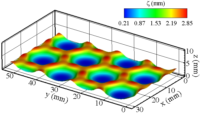Our work concerns transitions and instabilities in fluid flows at low and moderate Reynolds numbers.
Current and recent PhD students and postdocs:
Sébastien Gomé, Thesis:Transition to turbulence in plane shear flows (Advisors: L. Tuckerman and D. Barkley)
Tao Liu, Thesis: Dynamics of turbulent structures in plane Couette-Poiseuille flow (Advisors: R. Godoy-Diana, B. Semin and J. E. Wesfreid, defended on January 27, 2022)
Bluff-body wakes: cylinders, spheres, disks, cubes, propellers
The wake of an infinite-length circular cylinder undergoes a transition to a series of alternating transverse vortices called the Benard-von Karman vortex street. The wake of a three-dimensional object such as a sphere, disk, or cube leads to vortices aligned in the streamwise direction. Our experimental work traces the transitions in these flows.
Transition to turbulence in Poiseuille and Couette flows
 Turbulence is often considered to be the major unsolved problem in classical physics. The transition to turbulence in wall-bounded shear flows, has been a very active research area in recent years, especially from a dynamical-systems perspective. We carry out experimental, numerical, and theoretical research on Poiseuille (channel) and Couette flow, particularly in regimes in which laminar and turbulent regions coexist in the form of spreading turbulent spots or oblique turbulent bands. Numerically, we carried out the first computations of turbulent-laminar banded patterns in plane Couette flow and we have demonstrated that these can also exist in a variant of this flow with free-slip walls. Experimentally, we have been able to realize Poiseuille-Couette flow with no mean flow, allowing us to follow turbulent structures over longer times.
Turbulence is often considered to be the major unsolved problem in classical physics. The transition to turbulence in wall-bounded shear flows, has been a very active research area in recent years, especially from a dynamical-systems perspective. We carry out experimental, numerical, and theoretical research on Poiseuille (channel) and Couette flow, particularly in regimes in which laminar and turbulent regions coexist in the form of spreading turbulent spots or oblique turbulent bands. Numerically, we carried out the first computations of turbulent-laminar banded patterns in plane Couette flow and we have demonstrated that these can also exist in a variant of this flow with free-slip walls. Experimentally, we have been able to realize Poiseuille-Couette flow with no mean flow, allowing us to follow turbulent structures over longer times.
Rayleigh-Benard convection
In Rayleigh-Benard convection, a fluid layer is set into motion by a vertical temperature gradient. In addition to its major practical applications, this system is a paradigm of pattern formation, since it must organize itself in such a way that hot fluid rises at some locations and cold fluid falls at other locations.
Faraday instability and other surface wave instabilities

The Faraday instability leads to sub-harmonic standing waves on a fluid layer subjected to vertical oscillation. These waves may take the form of lines, squares, hexagons, or more exotic configurations. We carried out the first numerical simulations of the Faraday instability and have also explored the analogous instability on a sphere. We also investigate the form of a fluid interface subjected to horizontal vibration.
Alumni
- Matthew Chantry
- Lukasz Klotz
- Yacine Bengana
- Marie-Luce Nadal
- Ali-higo Ebo Adou
- Gregoire Lemoult
- Tao Liu


